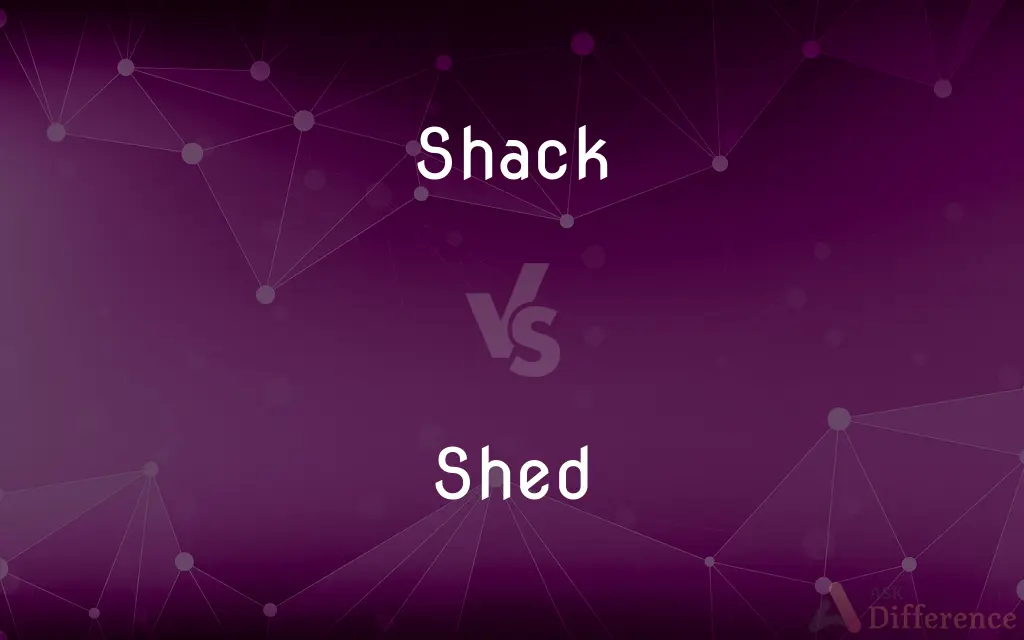Shack vs. Shed — What's the Difference?
By Maham Liaqat & Urooj Arif — Updated on February 27, 2024
A shack is a roughly built, often dilapidated structure used for shelter or housing, while a shed is a simple, single-story building used primarily for storage or as a workshop.

Difference Between Shack and Shed
Table of Contents
ADVERTISEMENT
Key Differences
Shacks are typically associated with makeshift construction and temporary use, often found in areas of poverty or as impromptu accommodations. They are constructed with available materials, without much attention to design or durability. Sheds, conversely, are purpose-built structures found in residential or agricultural settings, designed to store tools, garden equipment, or serve as workshops. They are more permanent than shacks and are usually built with a specific use in mind, reflecting a higher standard of construction.
The term "shack" often carries a connotation of substandard living conditions, highlighting the structure's inadequacy as a comfortable or safe dwelling. Sheds, however, are neutral in this regard, valued for their utility in storage and hobby activities without implications regarding living conditions.
Shacks are put together with whatever materials are at hand and may not follow a consistent design, leading to a wide variation in appearance and stability. Sheds are usually constructed from wood, metal, or plastic, following standardized designs that ensure functionality and durability.
Shacks may sometimes evolve from temporary shelter to more permanent habitation, adapting over time with improvements made as resources allow. Sheds, while potentially convertible into habitable spaces, are primarily designed for non-residential uses and maintain their identity as utility structures.
The distinction between a shack and a shed lies not just in their construction or intended use, but also in their place within societal norms and expectations. A shack is often seen as a last resort for housing, while a shed is a commonplace addition to a household or farm for practical storage and work space.
ADVERTISEMENT
Comparison Chart
Primary Use
Temporary shelter or housing
Storage or workshop
Construction
Makeshift, using varied materials
Purpose-built, often with standardized materials
Living Conditions
Often poor, associated with poverty
Not intended for living, neutral in terms of comfort
Durability
Generally low, varies widely
Higher, designed for longer-term use
Societal Perception
Associated with substandard living conditions
Viewed as practical and neutral
Compare with Definitions
Shack
Poor Living Conditions.
The shack offered little protection against the cold winter nights.
Shed
Workshop Space.
The artist converted her shed into a small studio for her sculptures.
Shack
Substandard Housing.
The earthquake left many people living in shacks due to the destruction.
Shed
Standardized Design.
The new shed was built from a kit purchased at the home improvement store.
Shack
Improvised Construction.
The shack was pieced together from old wood and metal sheets.
Shed
Outdoor Utility Structure.
The backyard shed serves as a convenient place to store bicycles and outdoor gear.
Shack
Makeshift Dwelling.
The family lived in a small shack on the outskirts of the village.
Shed
Non-residential Use.
They added a shed to their property for woodworking projects.
Shack
Temporary Shelter.
We built a shack to stay in while camping in the woods.
Shed
A shed is typically a simple, single-story roofed structure in a back garden or on an allotment that is used for storage, hobbies, or as a workshop. Sheds vary considerably in their size and complexity of construction, from simple open-sided ones designed to cover bicycles or garden items to large wood-framed structures with shingled roofs, windows, and electrical outlets.
Shack
A shack (or, less often, shanty) is a type of small, often primitive shelter or dwelling. Like huts, shacks are constructed by hand using available materials; however, whereas huts are usually rural and made of natural materials (mud, rocks, sticks, etc.) shacks are generally composed of scavenged man-made materials like abandoned construction debris, repurposed consumer waste and other useful discarded objects that can be quickly acquired at little or no cost and fashioned into a small dwelling.
Shed
A simple roofed structure used for garden storage, to shelter animals, or as a workshop
A bicycle shed
A garden shed
Shack
A roughly built hut or cabin.
Shed
An automobile which is old, worn-out, slow, or otherwise of poor quality.
Shack
A small, crudely built building; a shanty.
Shed
Garden Storage.
He stored his lawn mower and gardening tools in the shed.
Shack
A crude, roughly built hut or cabin.
Shack
Any poorly constructed or poorly furnished building.
Shack
A small simple dwelling, usually having only one room and of flimsy construction; a hut; a shanty; a cabin.
Common Curiosities
Can a shed be used as a living space?
While not designed for this purpose, some sheds can be converted into habitable spaces with appropriate modifications.
Can both shacks and sheds be found in urban areas?
Yes, both can be found in urban areas, though shacks are more likely in informal settlements, while sheds are common in residential backyards.
What materials are commonly used to build shacks?
Shacks are often built from scavenged materials like wood scraps, metal sheets, and other found objects.
Why are shacks associated with poverty?
Shacks are associated with poverty due to their makeshift nature and use as housing in the absence of better alternatives.
How do the functions of shacks and sheds differ?
Shacks serve as makeshift dwellings, whereas sheds are used for storage or as workshops.
Are sheds considered permanent structures?
Sheds are more permanent than shacks but are still considered accessory structures to a main building.
How does the public perceive shacks versus sheds?
Shacks are often viewed negatively due to their association with poverty, while sheds are seen as practical and useful additions to a property.
Are there any legal distinctions between shacks and sheds?
Legally, shacks might not be recognized as legitimate housing and could violate local building codes, while sheds are usually subject to specific regulations regarding their construction and use.
What role does a shed play in household management?
A shed plays a significant role in household management by providing additional storage space and potentially a workspace, helping to keep the main living areas uncluttered.
What is the typical size of a shed compared to a shack?
Sheds are generally small to medium-sized structures, while the size of a shack can vary widely based on its intended use and the materials available.
Is planning permission required to build a shed or shack?
This depends on local regulations, but sheds often require permission or must meet specific guidelines, while shacks, due to their informal nature, are typically built without official approval.
Can the construction of a shack be planned and designed?
While possible, the term "shack" usually implies a lack of formal planning or design, built out of necessity rather than choice.
Can shacks be found in all countries?
Yes, shacks can be found worldwide, especially in areas affected by poverty or natural disasters.
How are shacks and sheds similar?
Both shacks and sheds are simple, single-story structures that serve specific needs, though their purposes, construction, and societal perceptions differ.
How do environmental conditions affect shacks and sheds?
Shacks, due to their makeshift nature, are more vulnerable to environmental conditions, while sheds, being better constructed, can offer more protection against the elements.
Share Your Discovery

Previous Comparison
Accolade vs. Recognition
Next Comparison
Determination vs. StubbornAuthor Spotlight
Written by
Maham LiaqatCo-written by
Urooj ArifUrooj is a skilled content writer at Ask Difference, known for her exceptional ability to simplify complex topics into engaging and informative content. With a passion for research and a flair for clear, concise writing, she consistently delivers articles that resonate with our diverse audience.














































